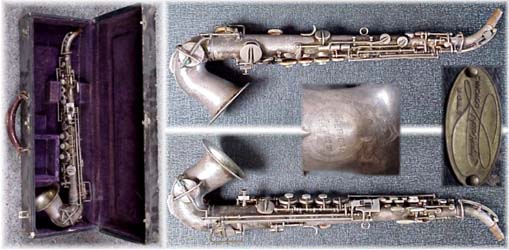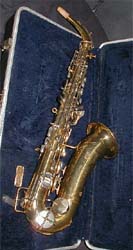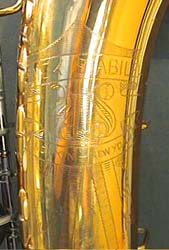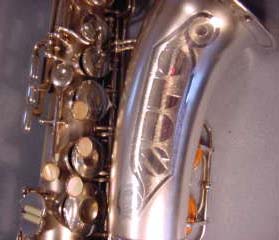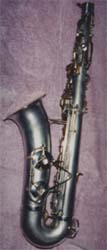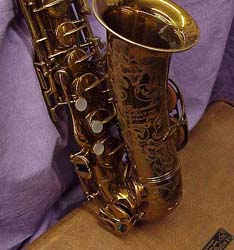 |
| This is just a small, and hardly comprehensive, collection of the many stencils made by Martin. Martin stencils are extrordinarily interesting for one major reason: many are exceedingly rare and are quite valueable. Some, like the Dick Stabile model, below, are MORE sought after and valuable than other Martin models. |
Lyon
& Healy Artist Model Perfect Curved Soprano ("Semi-Curved
Soprano")
(1925 to 1928) |
The question is: when is a stencil not a stencil? The standard definition of a STENCIL is a horn made by a major manufacturer for another company or storefront. On receipt of the horn, the 2nd party would literally take a stencil and engrave their own design on the horn. Stencils are generally variations on the major manufacturer's pro horns, but lack certian features (for example, Conn stencils lack rolled tone holes), were made with older tooling (for example, Buescher Elkharts were made with the Buescher True Tone tooling -- which was rendered obsolete about 10 years earlier), or suffered from poor quality control. The Lyon and Healy horns are different. Lyon and Healy DID make some of their own horns in the early 1900's, including saxophones, but they couldn't really compete with the big names, so they decided to stencil some horns, but a little differently: they decided to DESIGN some of their own horns and have other companies make them. The Perfect Curved soprano was designed by Lyon and Healy and sold (primarily) under their Artist brand name. These horns were produced in two "series": the first was a unique looking but "totally unplayable" version made by Holton that featured a detachable bell (and is currently so rare as to be non-existant) and the second is the model shown here made by Martin. This horn has considerably better intonation than the Holton-made version, but is still very hit-or-miss in general -- in other words, the horn the Perfect Curved was patterned after, the HN White King Saxello, is a much better horn, but the Perfect Curved soprano is worth more (around $3500+ US). For more information on these horns and Lyon and Healy, take a peek at the Vintage Saxophones Revisited columns in the May/June 1989 and the November/December 1997 editions of The Saxophone Journal magazine. |
| Dick
Stabile Models
(1935? to 1945?) |
|
| This is one of those few instances where the stencil is better than the original. The Dick Stabile model is probably the most sought after Martin model. It has extremely good intonation and has that distinctive Martin sound, plus it has many of the features of the Handcraft Committee and the keywork of the Handcraft Standard models. I have not been able to pin down the exact production years of this horn, but I'd assume production started around the time of the Handcraft Committee and was finished before the introduction of the Handcraft Committee II. |
|
| Olds
Super
(1941? to 1945?) |
|
| Martin was contracted as a stencil supplier to a wide variety of companies (Pedler, Lyon & Healy, etc.). However, most of the stencils Martin made were for the FE Olds company. However, the best of the Martin-made stencils is unquestionably the Super model. Here's some notes from an eBay ad: Olds (famous for its brass instruments) was awarded a government contract to supply instruments, including saxophones, to the military during the 2nd World War. A large number went down with a supply ship in the Mediterranean, and very few of the saxes survive today. There is some speculation that the instrument pictured here, with it's low serial number, may have been a pre-production model - either made to demonstrate the factory's capabilities to the government, or because Olds was trying to break into the professional sax market. Several unusual features can be seen in the photos. The silver tone ring (like those on [Olds'] brass instruments) reads: "Super Olds made by F. E.Olds and Son, Los Angeles, California U. S. A." (tone rings were also found on the Buescher 400 "Top Hat and Cane" and Super 400 models). The B and Bb keys are on the left side of the bell. The keys resemble flute keys, with their dimpled centers. The resonators are "rivet" style. Some of the features resemble pre-war Martin
Saxophones: beveled tops of tone holes; all keywork, tone-holes and
body joints silver-soldered. Some folks have questioned whether Martin actually made these horns because of some of the bizarre-looking features and odd keywork. I think it's definite that Martin made them, however, it may be that they didn't design them (see above on the Lyon & Healy horns). Here's why I believe that Martin made these horns: * There are only two makes of saxophone that I've ever seen with
bevelled tone holes: early Couesnons and all Martins. No, not conclusive evidence, but terribly persuasive circumstantial
evidence. |
|
| Reynolds
Models
(1961 to 1964) |
|
| These horns were Reynolds-labelled versions of the Committee ("The Martin ___"), with moderately different keywork and engraving. IMHO, I like the engraving on the Contempra model MORE than on the Committee. Confusing note: Reynolds liked the Contempra model name so much,
they recycled it. In the late 1960's, after Martin was purchased by
Wurlitzer, Reynolds stencilled a horn
from SML and used the same name. |
|
| Donate to the Vintage Saxophone Gallery Website | ||
|
|
||
Website copyright © 1997-2006 by Pete Hales.
Pictures/sounds/etc. used herein may have their own copyright and most are used by permission.
If you feel any image or soundbyte used here is in violation of copyright or for information regarding use/reproduction of this website's content, please e-mail saxpics@gmail.com
Comments, corrections, suggestions or picture submissions: saxpics@gmail.com
